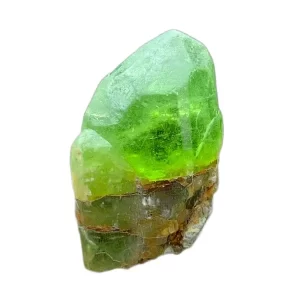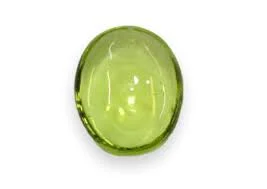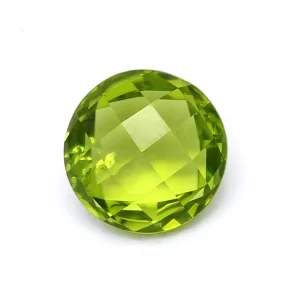
Peridot is a vibrant green gemstone treasured for its bright, lively color and ancient origins. Unlike many other gemstones, which form in the Earth’s crust, peridot is born deep within the mantle and is brought to the surface by volcanic activity—or, in rare cases, arrives via meteorites.

History & Lore
Composed of the mineral olivine, peridot is one of the few gemstones that occurs in only one color: green. However, its exact shade can range from golden-lime to olive or deep forest green, depending on the amount of iron present. Its name is believed to derive from either the Arabic faridat (meaning “gem”) or the Greek peridona (“to give in abundance”), reflecting both its brilliance and its symbolic associations with prosperity and warmth.
Peridot has been valued for thousands of years. Ancient Egyptians referred to it as the “gem of the sun,” believing it protected against nightmares and brought the wearer good fortune. It was mined on the Egyptian island of Zabargad (St. John’s Island) as early as 1500 BCE and was once mistaken for emerald due to its rich green hue. Throughout history, peridot has been a stone of light and transformation, linked to the sun, vitality, and renewal. As the birthstone for August, it symbolizes strength, growth, and a zest for life.

Meaning & Symbolism
Metaphysically, peridot is considered a cleansing and energizing stone. It is thought to activate the heart and solar plexus chakras, encouraging openness, compassion, and personal empowerment. Peridot is often used to dispel negative emotions such as jealousy, resentment, or self-doubt, replacing them with confidence and emotional clarity. Its refreshing energy is said to support emotional healing, attract abundance, and promote inner peace. Because of its connection to light and warmth, peridot is also associated with joy, creativity, and a sunny outlook.
Origin & Regionality
Peridot is found in a variety of locations around the world, often in regions with past or present volcanic activity. One of the most historically significant sources is Zabargad Island in the Red Sea, where ancient Egyptians mined the gem for centuries. Today, some of the highest quality peridot comes from Pakistan, particularly from the rugged Kashmir region, where vivid green crystals are found in dramatic mountain environments. Myanmar (Burma) is another respected source, producing rich green stones prized for their clarity and saturation.
In the United States, Arizona is the most well-known producer, especially on the San Carlos Apache Reservation, where Native American communities mine gem-grade peridot from volcanic basalt flows. Other U.S. states with peridot deposits include Hawaii and New Mexico. Peridot has also been discovered in China, Vietnam, Tanzania, and Norway, each producing stones with slightly different color characteristics.
Interestingly, peridot has also been found in meteorites, known as pallasites, making it one of the few gemstones with extraterrestrial origins. These rare specimens are highly prized by collectors and gem enthusiasts alike. Whether formed deep within the Earth or carried to us from the stars, peridot’s glowing green hue and powerful symbolism make it a truly celestial stone of light, renewal, and vitality.

